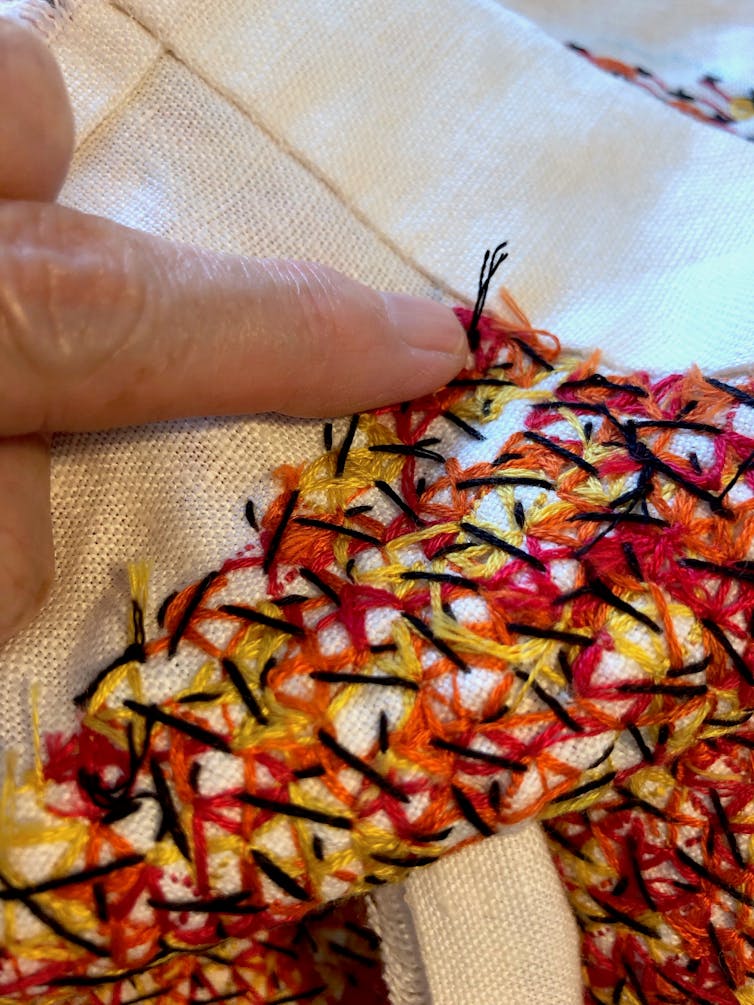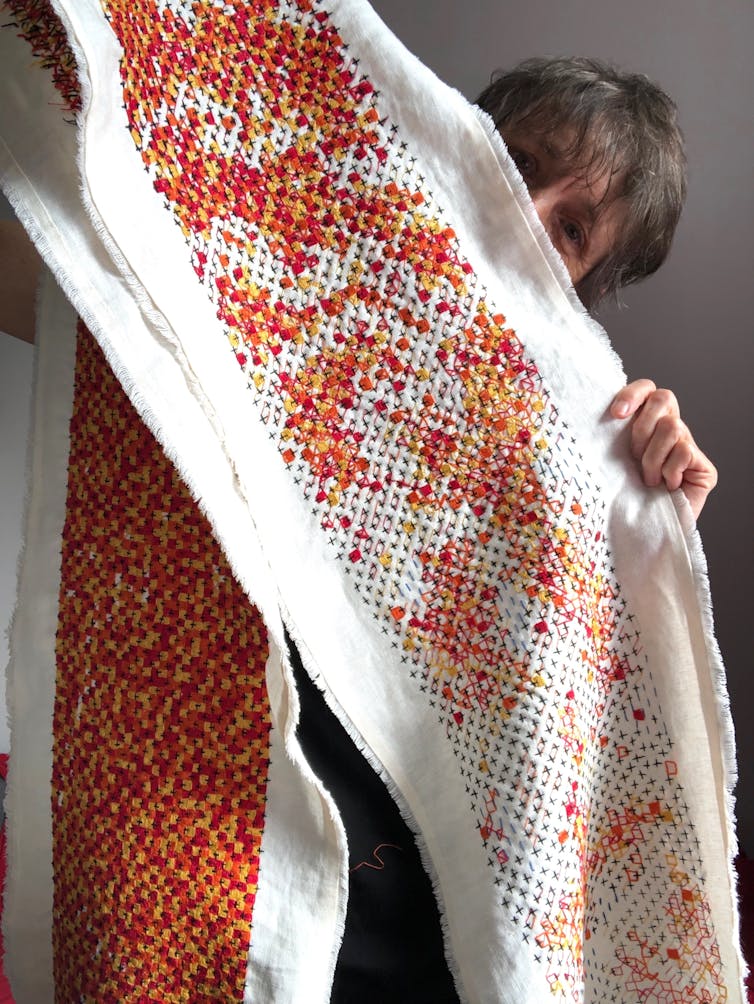I slip the needle through a small loop of black thread, pull it tight and snip. Done. I have just tied off the very last stitch on an embroidered scroll that has taken me more than 500 hours across 19 months to complete.
All of my artwork is extremely labour-intensive. But I have to admit, this is a bit excessive, even for me. It’s not surprising that I have been asked more than once “why not just outsource the labour?” and even “what is the point?”
I always sigh and think enviously of plumbers. I am 100% sure hardworking tradies are never asked to justify the point of their work.
Why do I work so hard? There is no one easy answer, it’s different every time. The labour intensity of my processes adds time into the equation and this both carries meaning and can change the meaning of the work as it goes on (and on and on). I always learn something unexpected.

I put my little scissors down and, before busting out the bubbles, I snap a picture for Instagram because #selfpromotion, but also because this is news, albeit of a very slow-breaking kind. This is what I’ve learned after stitching for seemingly endless hours: while no news may be good news, “slow news” is even better.
My embroidered scroll is titled Impossible Numbers. It started as my attempt to memorialise the estimated 3,000,000,000 non-human lives lost in the devastating bushfires of 2019–20, a number impossible to actually comprehend.
Doomscrolling an emergency
During that long and awful summer Sydney was often shrouded in an eerie orange haze. You could smell smoke. Ash fell. But, like many Australians, I experienced the worst of it by doomscrolling fast news.
I was both horrified and fascinated by images of fires so huge and hot they generated their own weather, by pictures of houses reduced to smoking skeletal outlines that somehow remained standing, by headlines comparing the fires to armageddon and the apocalypse.
This hyperbolic language implies we are locked in a war of good versus evil. Even headlines in the vein of “Firefighters battle blazes” pit us (people) against them (the forces of nature). And in the heat of the moment the language of war feels right. I’ve succumbed to it myself. But it is dangerous. This language reinforces the idea we can dominate nature; it frames the fires as a conflict that we can end by winning.

I will admit watching a goat-toting woman berate a sitting prime minister left me with a short-lived, but mildly satisfying, feeling of shared righteous indignation. But mostly doomscrolling just fuelled my sorrow and left me feeling impotent as, inevitably, the fast news cycled on to the next crisis (and the next, and the next).
Slowing it down
In October 2022, I finally stopped trying to process the bushfires, and all their terrifying implications, through the fast-news language of war. I picked up a needle instead.
Of course 3,000,000,000 stitches would be too many, even for me, so I decided to stitch a grid of some 15,000 squares, which I filled with innumerable stitches – a nod to the endless stream of pixels that usually deliver our news.
I started wanting to honour the 3 billion dead, that impossible number, but after months of stitching I realised I was “writing” a kind of slow-news story. It may sound ridiculous, but this tactic has been used before. The Bayeux Tapestry is a slow-news story that documents the Norman conquest of England through embroidery. It took years to stitch, and some 950 years later it is still in circulation.
As an alternative to doomscrolling easily digestible fast-news stories of good triumphing (or not) over evil, I have created an actual fabric scroll which depicts a stylised firestorm building in intensity until it becomes all-consuming.

Despite mimicking pixels, Impossible Numbers is resolutely handmade. It is too messy, too crude, to be anything else. It is bleedingly obvious (and there was blood) the will of a person is inextricably stitched into this image of devastating fire. Human labour is literally entangled in this artwork; it shows us as part of the picture, part of nature. And this is good news
Impossible Numbers doesn’t have a victorious ending, or any ending at all. The scroll is not fully unrolled. There is no end in sight: the story isn’t over, it’s ongoing.
In this way it points to the future; a future in which we are not fighting nature. And this is good news too.
If you don’t have a spare 500 hours to process the news into slow news, don’t worry. By the time I finally tied my last knot, I found I had transformed my fear and rage into something tangible, something both magnificent and beautiful (if I do say so myself), no longer about me.
It is now a slow-news story that is no longer about a particular event; something everyone can share. This is why I do the work.
Impossible Numbers is on display as part of The Blake Prize at the Casula Powerhouse, Sydney, until July 7.
This article is part of Making Art Work, our series on what inspires artists and the process of their work.

